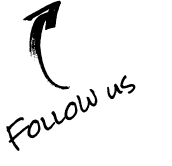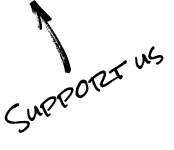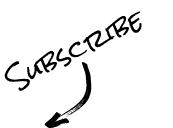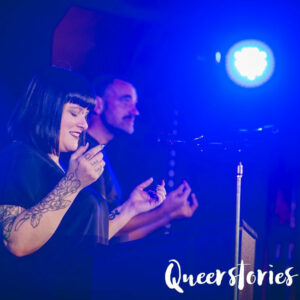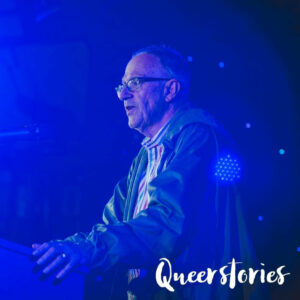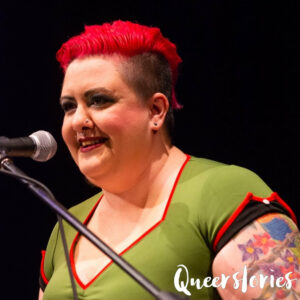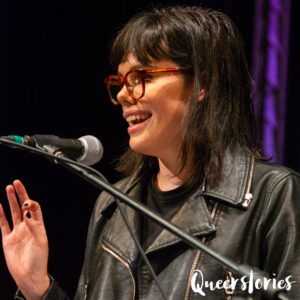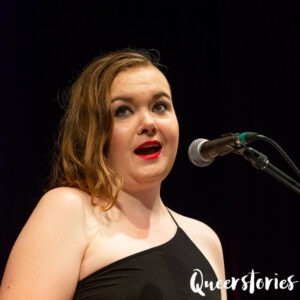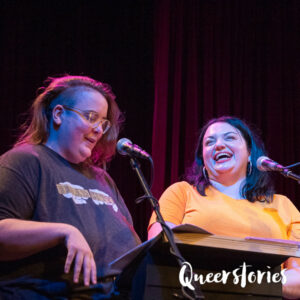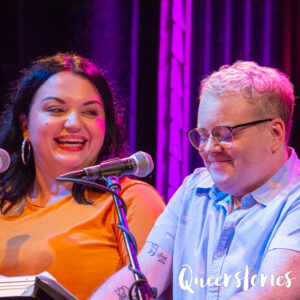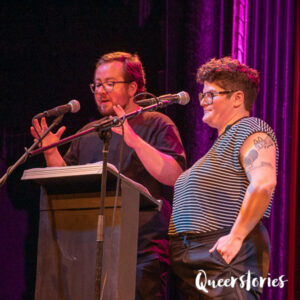Transcript:
Hi. I’m Maeve Marsden and welcome to Queerstories – the podcast for the LGBTQI+ storytelling night I host and programme. Queerstories events happen regularly in Sydney, Brisbane and Melbourne, and I’m also now hosting them in regional towns. If you enjoy these stories, please rate, review and subscribe to the podcast, and consider buying a copy of the Queerstories book: A collection of 26 of the stories edited by me and published by Hachette. I’m really proud of this collection and I hope you enjoy it too. Crusader Hillis is a writer, editor, curator and producer. He co-founded – with Rowland Thomson – the queer bookshop Hares & Hyenas. Since 1991, Hares & Hyenas has presented more than 1,000 literary performance events, both in Melbourne on-site and interstate. Crusader performed at the Melbourne book launch for the Queerstories book in September 2018.
I would like to acknowledge that we’re meeting on Wurundjeri land, and if there are any Wurundjeri people in here tonight, I hope you welcome me here. The Wurundjeri are of the Woiwurrung first nation. They have alliances with other first nations and clans that border these lands. I pay my respects to the Wurundjeri, the Boonwurrung, the Taungurong, the Djadjawurrung, and the Wathaurong people of the Kulin nations. Always is Aboriginal land.
In 1978, my best friend and mainstay – then and still – Rowland Thomson, moved to Canberra for study. During a break, he came back to Melbourne and stayed in my share house. He brought with him Patti Smith, New York Dolls and Television records, and through one memorable afternoon we played them all, and the dye was cast.
Over the next few months, Rowland back in Melbourne collected more punk music from here and overseas, and his vinyl collection grew exponentially. We saw punk bands during the day at Melbourne University and other campuses, and at night at venues mostly in Fitzroy, Carlton and St Kilda. He was 22, I was 21. We were old for the scene. We knew people as young as 15 who were going out regularly, and I had a car so we made friends quickly. Within a year, we had formed The Delicatessens, an up to 14-piece punk cabaret cover band, which reworked pop songs and covered some of the punk scene’s favourite bands and songs; always to their displeasure.
Our music was atrocious, pretty much on purpose. It was described as Dadaesque happenings. The energy of so many people on stage and the cacophony that we created was a drawcard, and we got bookings at the Crystal Ballroom, the Prince of Wales, and the Exford Hotel, as well as a bunch of pop-up events across the city.
Dolores San Miguel was running the Crystal Ballroom at the time, and she was a fan and put us on as support acts to well-known local bands. We also performed regularly at the Little Bands nights at the Champion Hotel in Fitzroy, and our anarchic approach fitted in well with what were mostly electronic and experimental post-punk ensembles with real musical credentials. Rowland was also a member of the Beaumaris Tennis Club Quartet, a costumed parody trio, and the more serious Human Backs, a post-punk electronica trio, which did quite a lot of cabaret and live cooking on stage.
*Audience laughs*
And they went on to support Dead Can Dance in their last Melbourne performance and also the Birthday Party when they left Melbourne to go to England. And then both of those bands went on to international success. The Human Backs put out at least one – was it a CD by that stage? Cassette. Thank you, Rowland.
The Crystal Ballroom in Fitzroy Street, St Kilda, gathered all sorts of bands and audiences, and people travelled from all over to get there. It also got the big international punk bands that packed the entire venue. Rowland and I, and others in our gang, developed a unique movement at the Crystal Ballroom where a group of up to 12 of us would get on our hands and knees, hold on to the person in front, and move from the back of the room around the legs of the crowd to travel the 30 or 40 metres to the very front of the room. Then we just popped up where we found space. We always got the best standing room in the entire venue.
Rowland and I had been best friends for five years before we became lovers, and we’d come out to one another a couple of years earlier than that. We lived in an inner-city bubble where our friends, housemates and workmates – all straight – accepted us totally. When we hit the Melbourne punk scene, we found the same attitude. Every night we found somewhere to go to see a band, crash a gallery launch or see some performance art with a list of geographically sorted parties to follow.
The punk scene was at its height shortly after the gay liberation movement in Melbourne began. There were lots of queers in the scene but it wasn’t necessarily their main identity. Sexuality and gender expression were more fluid. And most of my male sexual partners were ostensibly straight, but we found ourselves in sexual situations that were not a cause for panic or concern for either of us. It was a time of experimentation and I never felt sidelined because of my sexuality. However, I also had good instincts about who was uncomfortable hanging around faggots and I didn’t seek those people out.
We went out together away from the punk scene, sometimes to gay clubs, we did it in intoxicated packs – straight, gay, male, female; a mix of all. Melbourne was tipping from punk into post punk, and we dressed in a mix of black garb, and clashing colours and shapes, as New Wave and pre-New Romantic fashions were hitting the scene. We stood out, which we liked and, mostly, we were accepted.
Women were huge contributors in the punk and post-punk music scene, and I rarely witnessed sexist displays. My friends were made up of pretty much equal numbers of men and women, and some who defied any easy definition.
Occasionally, it was dangerous. There was often harassment on the streets, and you were a target for being pulled over by police just for walking home late at night. It happened three times in one night, with Rowland memorably kicking the wheels of the police car in frustration, and eventually, they came over and said, “Are you okay?” And he said, “This has happened three times.” And, “We’re very sorry.” And then we just went home after that.
In my early 20s, sex was memorable for the public places it happened. My inhibitions would be gone through alcohol or drugs. I had sex in cars, in parks, behind the black plastic sheeting downstairs at the Crystal Ballroom, in the women’s toilet during a pub night, on a backyard lawn during a busy party, and at the St Kilda triangle where sex was sold in cars, and behind the back wall of a Greek nightclub.
I picked up one partner at a concert. It was early 1980. I had taken half a bottle of tiny asthma tablets that I bought from a chemist. They cost two dollars for 100. The effects lasted about three hours and felt like a combination of low-grade speed and Rohypnol. I was very confident but I was very uncoordinated.
*Audience laughs*
I’d spoken to him at a party the week before. He was a bass player in two bands. He was a few years older than me, and he had a rangy body and craggy good looks. He was flattered when I told him he was good looking, and we spent the first of many nights together.
Within days, he and I were using drugs together, my first time intravenously. Over the next few months, our occasional sex was comradely, not passionate; mostly about the drugs. In public, though, it was often a spectacle. One night, I sucked his cock in a car ride home from a party where we had sex on a sofa for three hours while our straight friends grabbed drinks from the esky next to us.
*Audience laughs*
I slept at his house every couple of weeks, slipping unannounced through his housemate’s front window. None of his housemates minded me being there, including his on-again, off-again girlfriend who sometimes I bumped into in his bed, or maybe just changed places with.
Neither of us came very often during sex, but we shared blood. Hepatitis B was rampant and it was talked about. Some of my friends were carriers but most recovered, and it would be another 12 years before the Hepatitis C test would be available, revealing an epidemic of infection amongst my music scene friendship group. Rowland and I first fucked on the night of a Federal election in October 1980.
*Audience laughs*
It’s the only reason we can actually remember and find out the date. And it actually took us about fifteen years to actually work out which election.
*Audience laughs*
It was after a party above where the Black Cat is now on Brunswick Street. I was sharing his bed, as I often did when I was “between houses” which I often was. I don’t remember if we started out sleep-fucking or fully conscious, but despite our clumsy fumblings, we both came pretty quickly.
The next morning, Rowland said, “I thought you’d be more confident. You’ve had plenty of sex.” He’d noticed I was shy and reticent about my body and about taking initiative. He didn’t sound disappointed, he was only curious. I’m not sure if I answered. I didn’t have a language to speak about what had just happened between us. But it was the first time someone I had sex with had asked me how I had felt about it.
Within two months of getting together with Rowland, I moved to Sydney and stayed there for 16 months. We saw each other at least once a month. Hitchhiking from Sydney to Melbourne and back again, usually with female friends, became an affordable way of maintaining contact. I moved back to Melbourne in April 1982 after a fairly traumatic bashing by a dozen skinheads on the way home from a club.
We’ve never had an exclusive relationship, but it wasn’t until the end of the 1980s that we started to experiment more widely with sex. The UK Second Summer of Love hit Melbourne in early 1989, and Rowland and I worked on the door of a club that modelled itself on the movement’s acid house music and trippy hedonism. The owners of the night had lived that entire year in England just before, so they were still very high.
*Audience laughs*
And also a shout out to the first [inaudible 00:11:20] “I’m high too.”
It was on one of these nights that I met a Singaporean pilot and went with him to 55 Porter Street, a gay sauna. In the late 1980s and 1990s, saunas were often packed at the weekends. I discovered the joy of the darkroom. Not only was the place pitch black, silence was encouraged. Towel dropped, cock out, it was thrilling to be desired by so many available men. I had found the place where I was no longer shy. The dark gave me permission to explore.
Our bookshop, performance venue and community hub that we co-created, Hares & Hyenas, is built on the ethos and organising principles of punk. It’s a place of free expression, where the only question is, “What are the technical requirements?”
We need a place that doesn’t judge. We need a place that keeps the words of the last century alive for new readers, opening up the words and ideas of the present and the future. We need a place that brings the experience of the most marginalised queers to the centre, and Hares & Hyenas is that place.
Hares & Hyenas was named after a dream Rowland had of John Boswell’s 1980 book, Christianity, Social Tolerance and Homosexuality, which in many ways rivals Foucault in queering theory; especially that far back. And the book has artworks of hares, hyenas, moles, weasels, and stoats as animals associated with divergent sexuality and gender. And, I bet you’re asking yourself why we didn’t call ourselves Moles, Weasels and Stoats, but you know.
*Audience laughs*
It was always the plan for the secondhand bookshop we never quite got around to opening.
Those animals stood in this book and in his study as being homosexual, intersex, transgender, gender changing, night animals, witches companions; that is us, I thought.
About a week before opening, Rowland woke up in the night and said, “Hares and Hyenas,” and then the shop was born. It was the perfect name to call a bookshop that imagined its customers coming also from beyond the binary of the times, which was gay and lesbian. That vision persists, and 27 years later, we’re as relevant today as when we opened, and maybe more so. Thank you.


